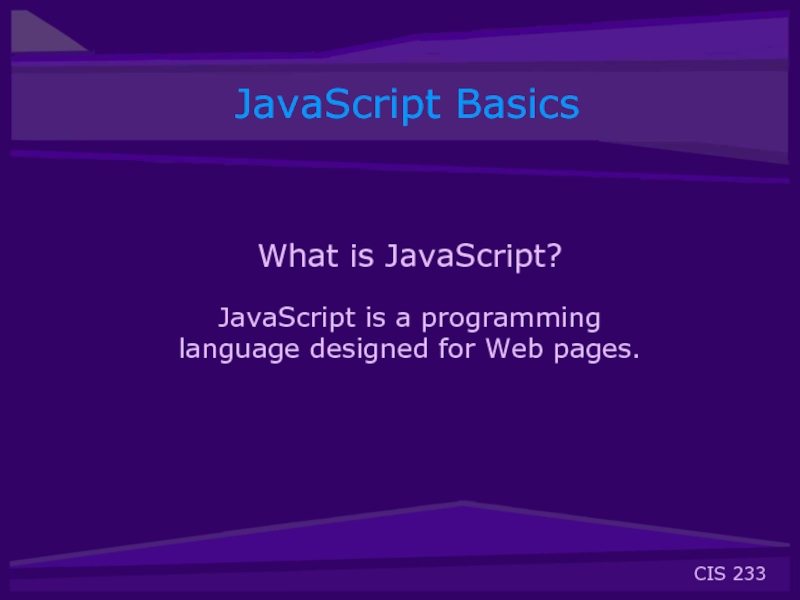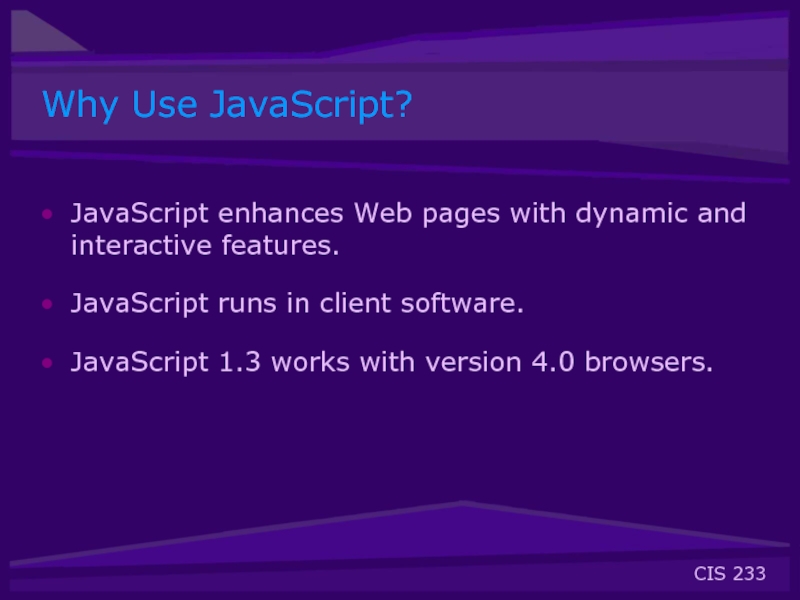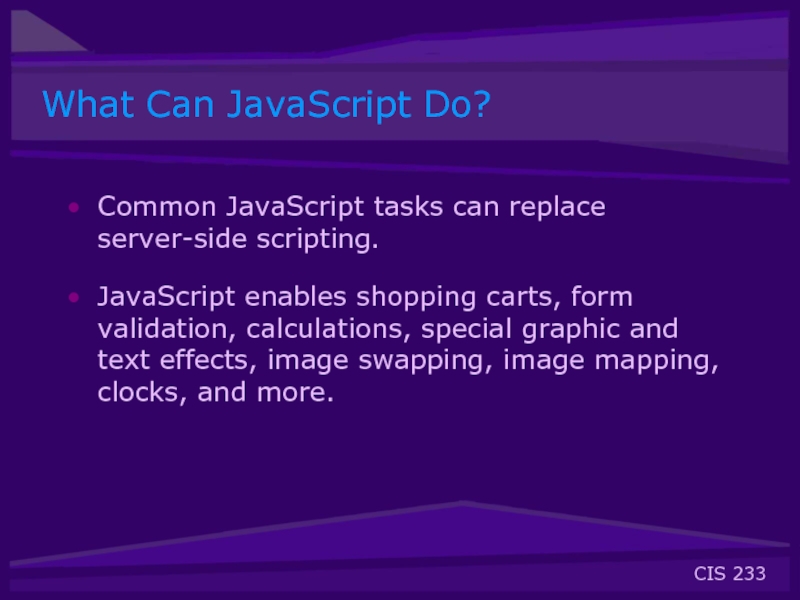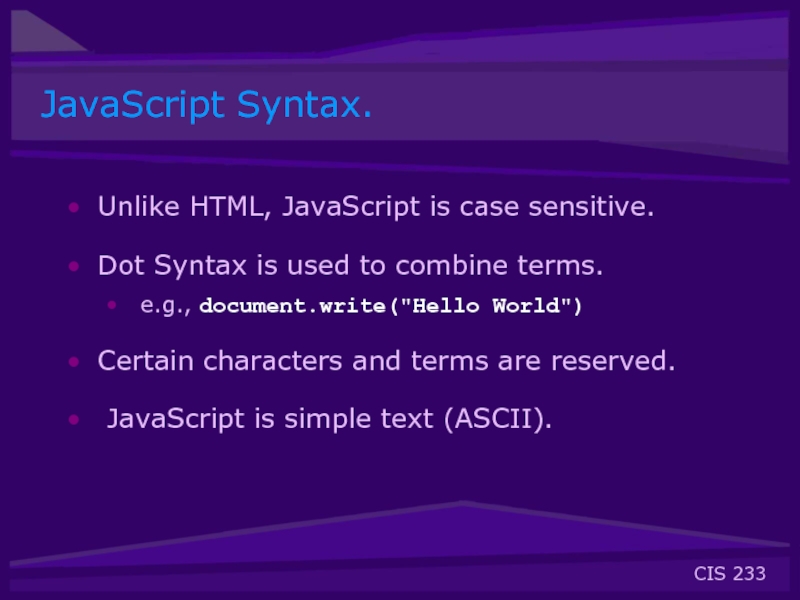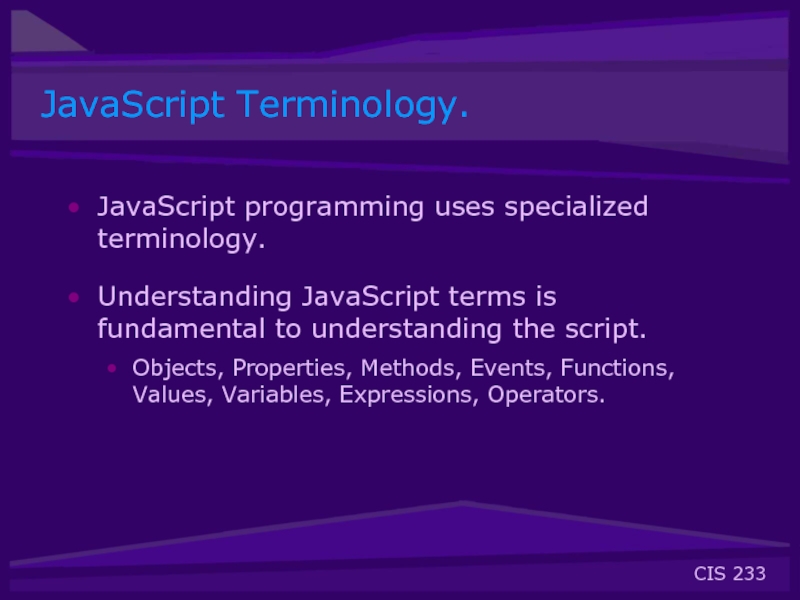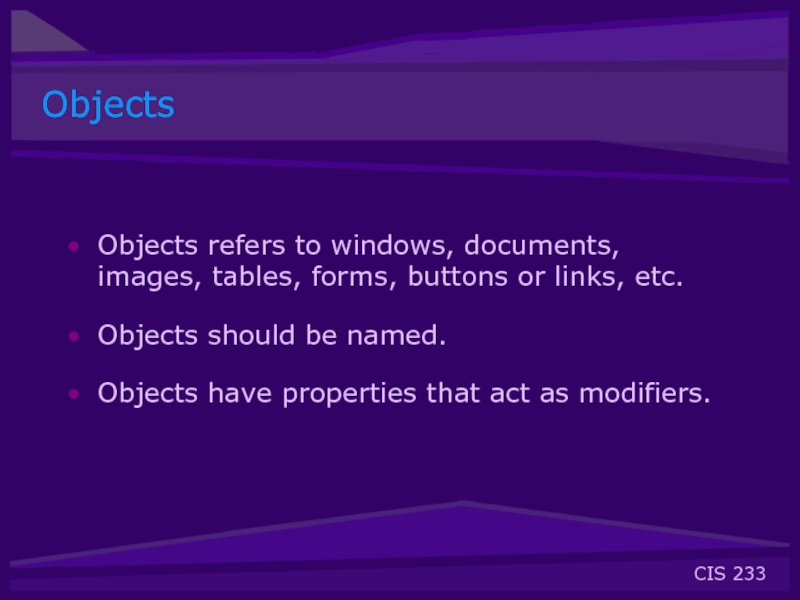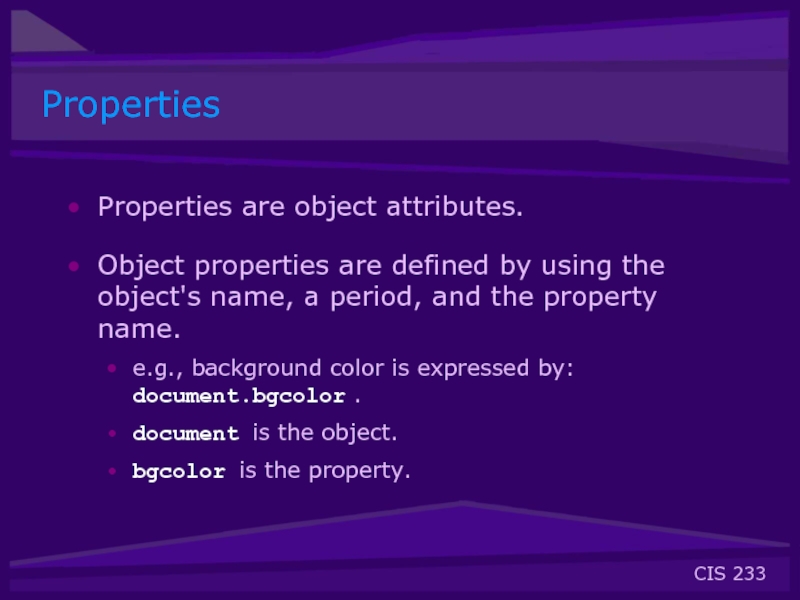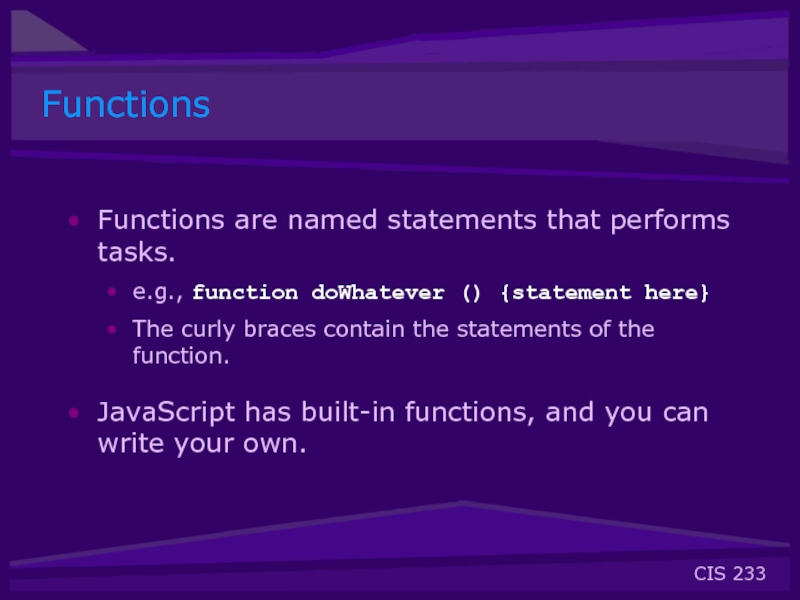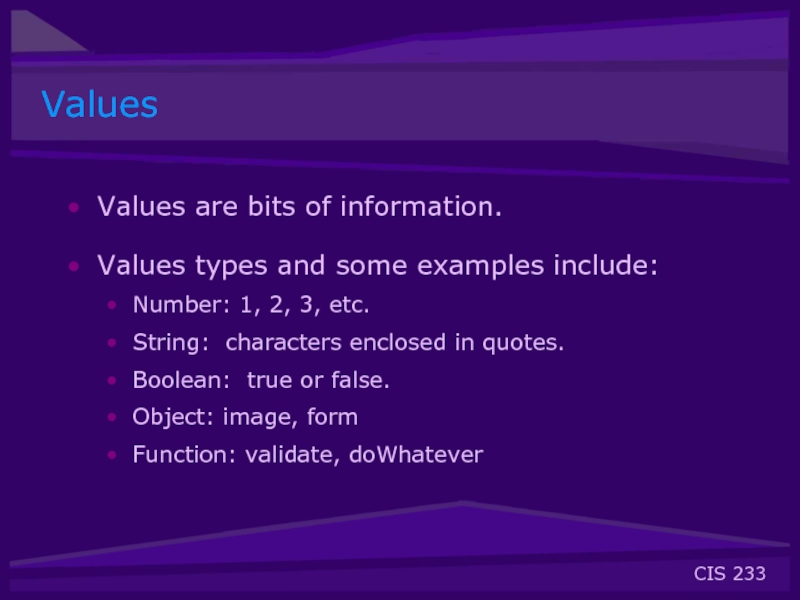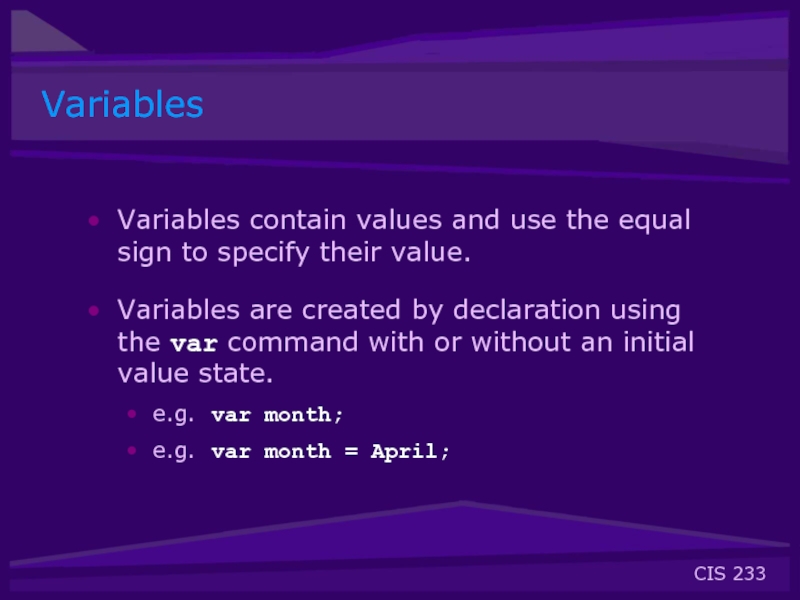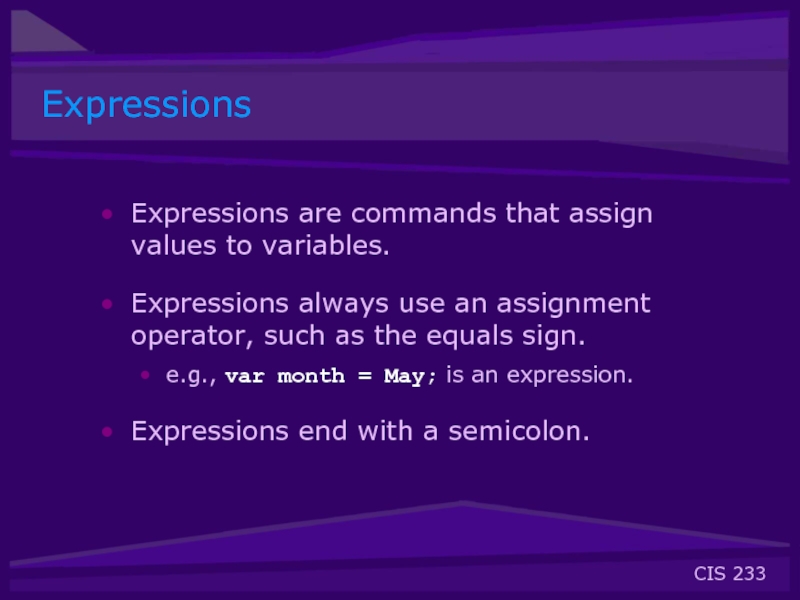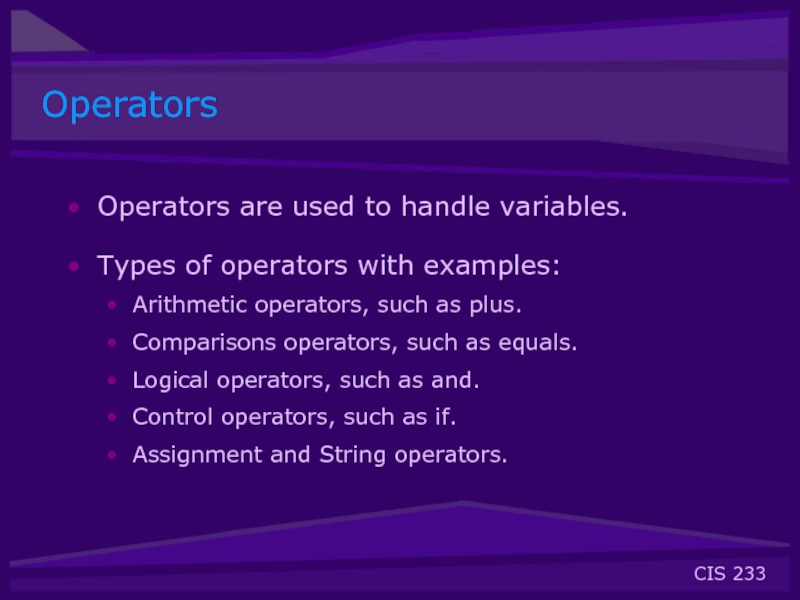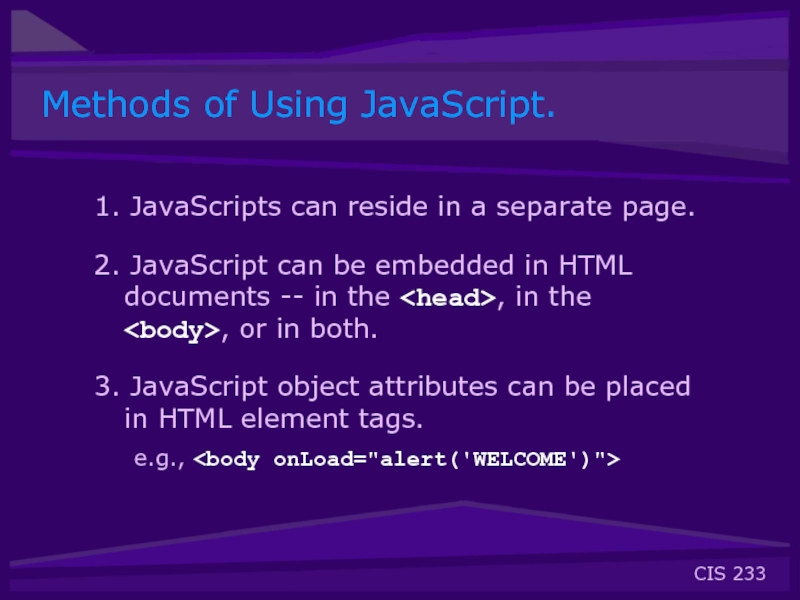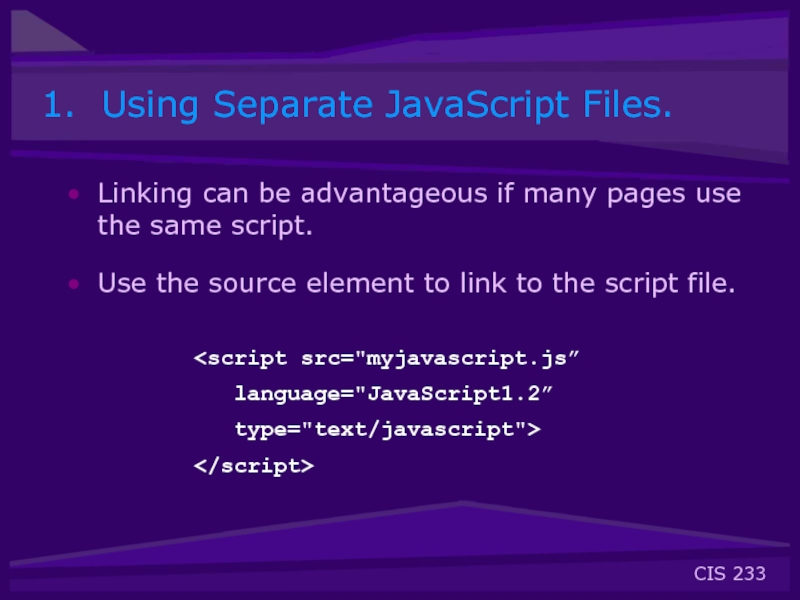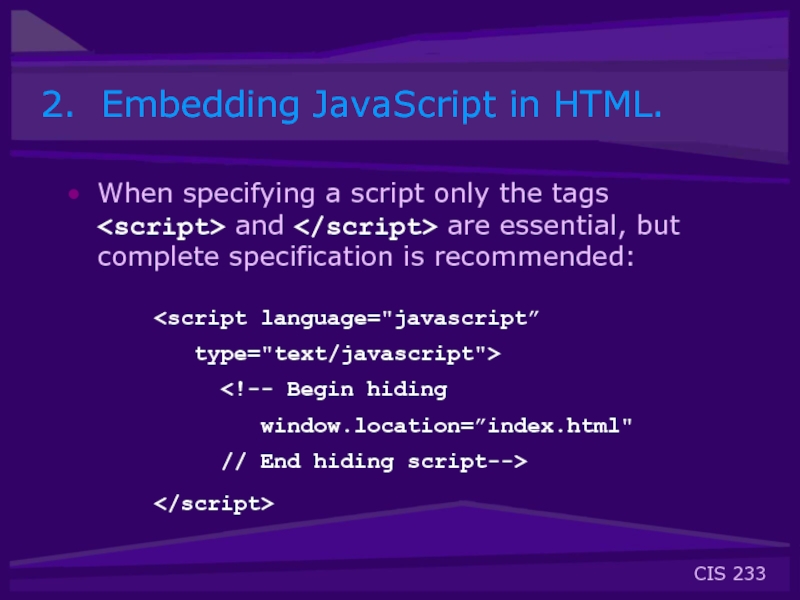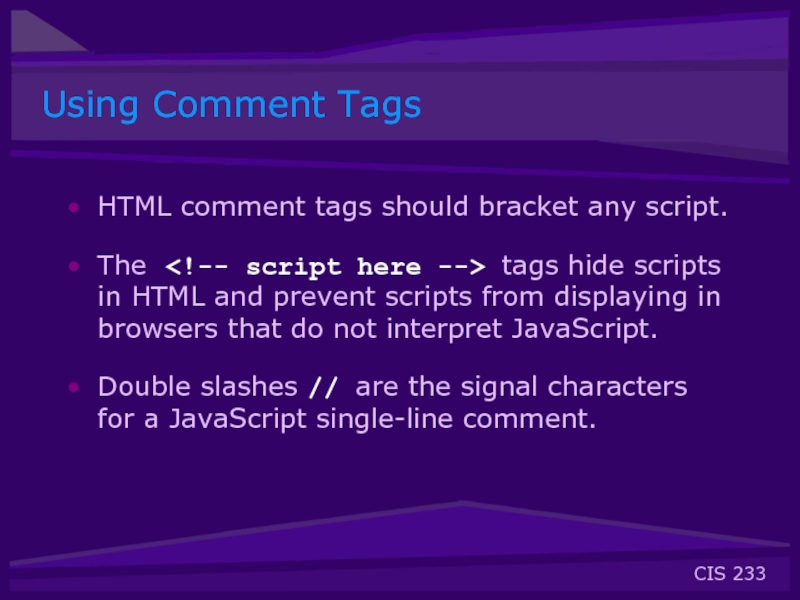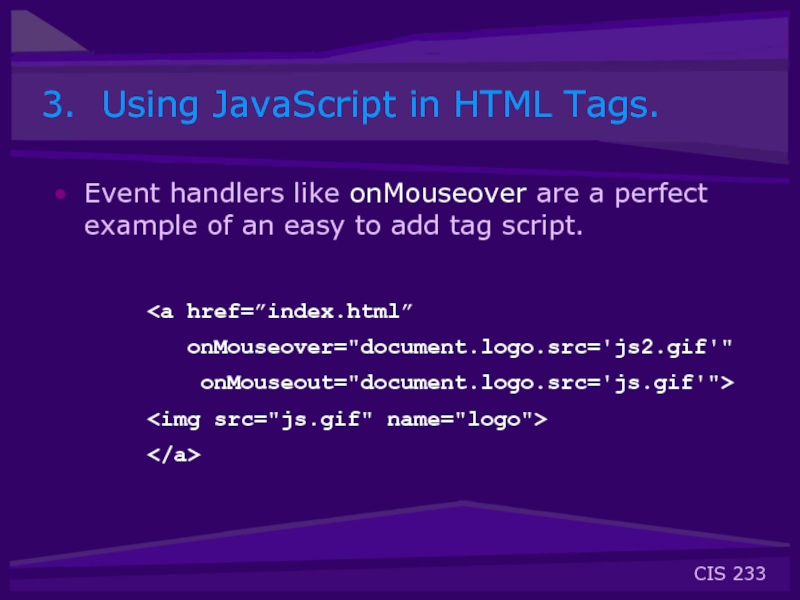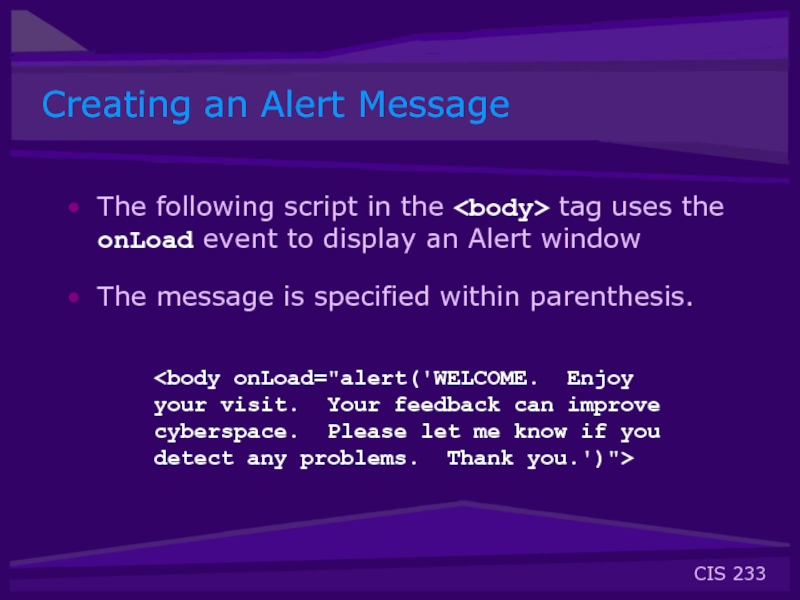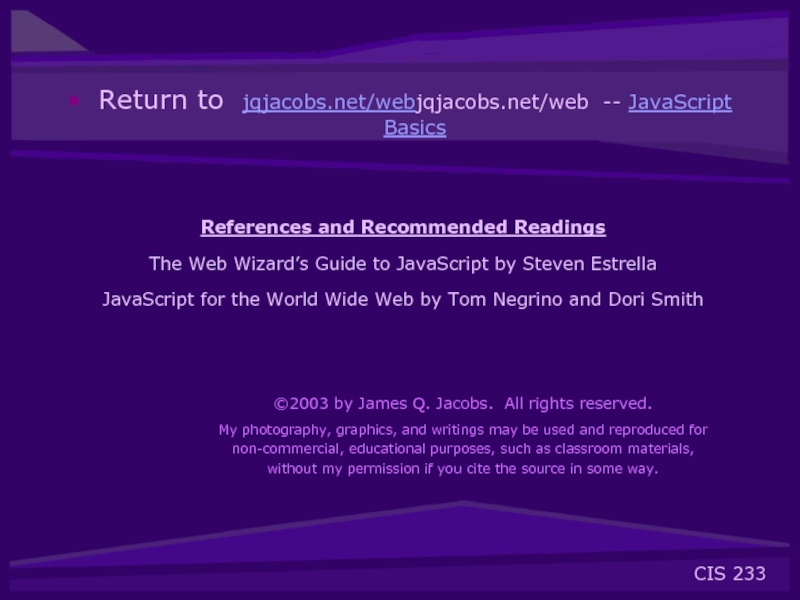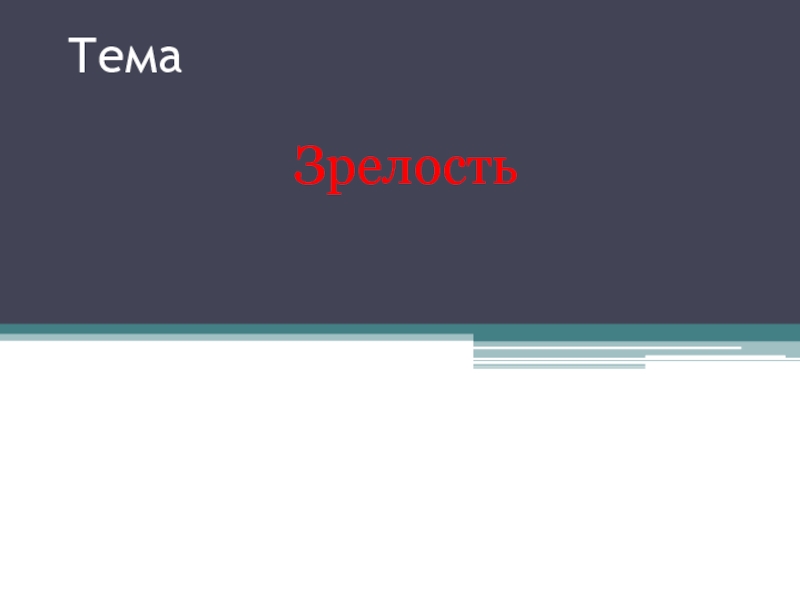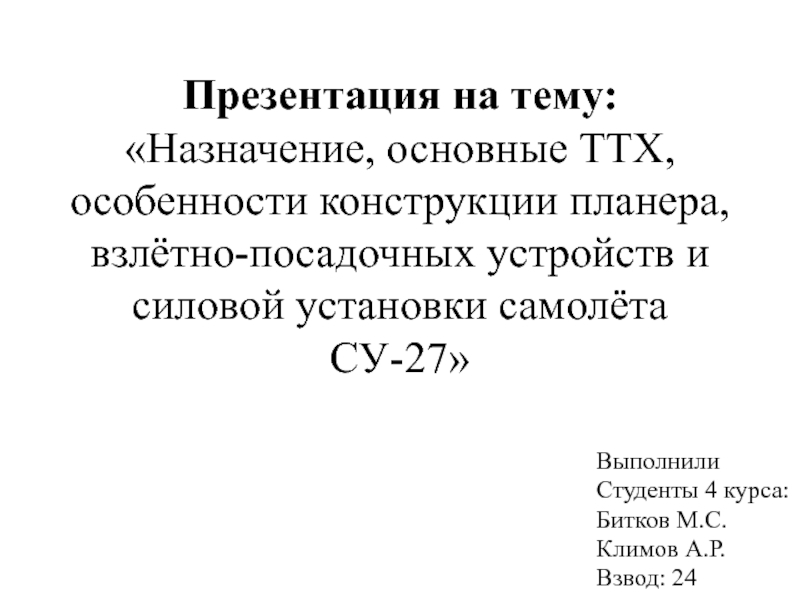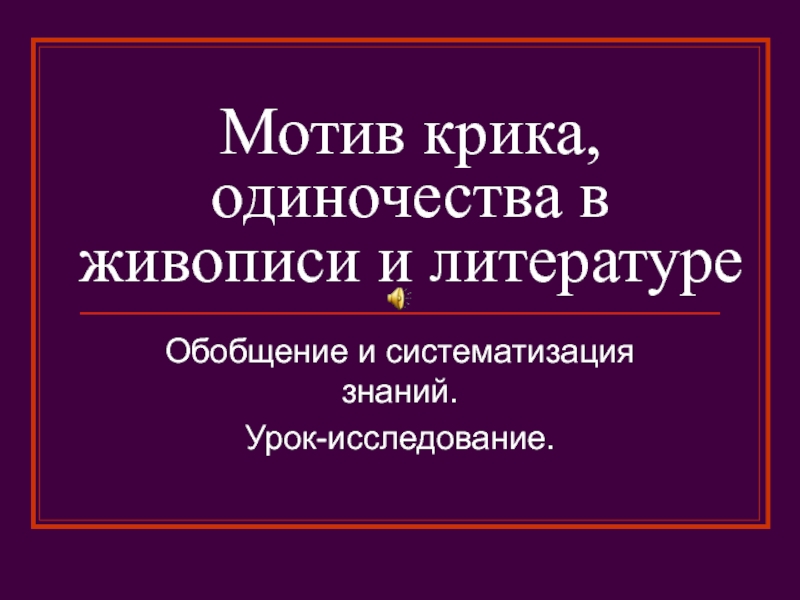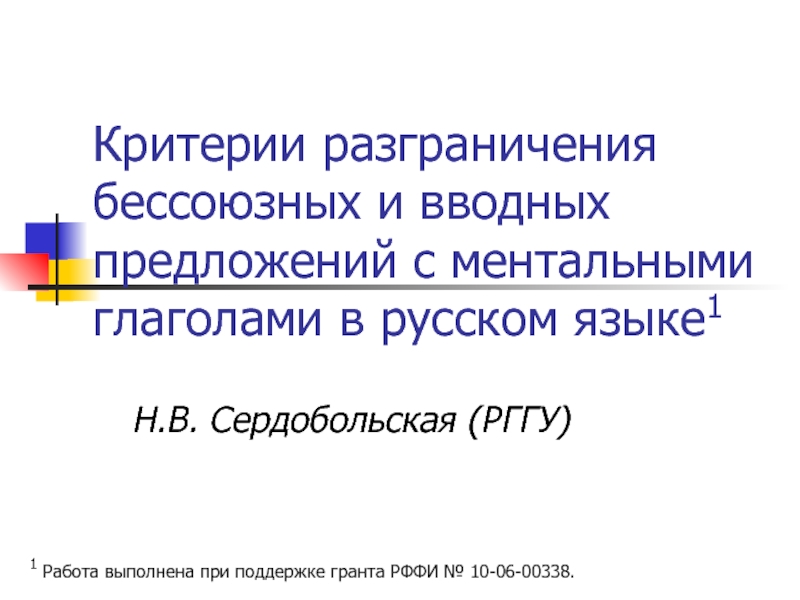- Главная
- Разное
- Дизайн
- Бизнес и предпринимательство
- Аналитика
- Образование
- Развлечения
- Красота и здоровье
- Финансы
- Государство
- Путешествия
- Спорт
- Недвижимость
- Армия
- Графика
- Культурология
- Еда и кулинария
- Лингвистика
- Английский язык
- Астрономия
- Алгебра
- Биология
- География
- Детские презентации
- Информатика
- История
- Литература
- Маркетинг
- Математика
- Медицина
- Менеджмент
- Музыка
- МХК
- Немецкий язык
- ОБЖ
- Обществознание
- Окружающий мир
- Педагогика
- Русский язык
- Технология
- Физика
- Философия
- Химия
- Шаблоны, картинки для презентаций
- Экология
- Экономика
- Юриспруденция
JavaScript Basics презентация
Содержание
- 1. JavaScript Basics
- 2. Why Use JavaScript? JavaScript enhances Web pages
- 3. What Can JavaScript Do? Common JavaScript tasks
- 4. JavaScript Syntax. Unlike HTML, JavaScript is case
- 5. JavaScript Terminology. JavaScript programming uses specialized
- 6. Objects Objects refers to windows, documents, images,
- 7. Properties Properties are object attributes. Object
- 8. Methods Methods are actions applied to particular
- 9. Events Events associate an object with an
- 10. Functions Functions are named statements that performs
- 11. Values Values are bits of information.
- 12. Variables Variables contain values and use the
- 13. Expressions Expressions are commands that assign
- 14. Operators Operators are used to handle variables.
- 15. Methods of Using JavaScript. 1. JavaScripts
- 16. 1. Using Separate JavaScript Files. Linking can
- 17. 2. Embedding JavaScript in HTML. When specifying
- 18. Using Comment Tags HTML comment tags should
- 19. 3. Using JavaScript in HTML Tags. Event
- 20. Creating an Alert Message The following script
- 21. Return to jqjacobs.net/webjqjacobs.net/web -- JavaScript Basics ©2003
Слайд 1JavaScript Basics
What is JavaScript?
JavaScript is a programming language designed for Web
Слайд 2Why Use JavaScript?
JavaScript enhances Web pages with dynamic and interactive features.
JavaScript runs in client software.
JavaScript 1.3 works with version 4.0 browsers.
Слайд 3What Can JavaScript Do?
Common JavaScript tasks can replace server-side scripting.
JavaScript enables
Слайд 4JavaScript Syntax.
Unlike HTML, JavaScript is case sensitive.
Dot Syntax is used
e.g., document.write("Hello World")
Certain characters and terms are reserved.
JavaScript is simple text (ASCII).
Слайд 5JavaScript Terminology.
JavaScript programming uses specialized terminology.
Understanding JavaScript terms is fundamental
Objects, Properties, Methods, Events, Functions, Values, Variables, Expressions, Operators.
Слайд 6Objects
Objects refers to windows, documents, images, tables, forms, buttons or links,
Objects should be named.
Objects have properties that act as modifiers.
Слайд 7Properties
Properties are object attributes.
Object properties are defined by using the
e.g., background color is expressed by: document.bgcolor .
document is the object.
bgcolor is the property.
Слайд 8Methods
Methods are actions applied to particular objects. Methods are what objects
e.g., document.write(”Hello World")
document is the object.
write is the method.
Слайд 9Events
Events associate an object with an action.
e.g., the OnMouseover event
e.g., the onSubmit event handler sends a form.
User actions trigger events.
Слайд 10Functions
Functions are named statements that performs tasks.
e.g., function doWhatever ()
The curly braces contain the statements of the function.
JavaScript has built-in functions, and you can write your own.
Слайд 11Values
Values are bits of information.
Values types and some examples include:
Number:
String: characters enclosed in quotes.
Boolean: true or false.
Object: image, form
Function: validate, doWhatever
Слайд 12Variables
Variables contain values and use the equal sign to specify their
Variables are created by declaration using the var command with or without an initial value state.
e.g. var month;
e.g. var month = April;
Слайд 13Expressions
Expressions are commands that assign values to variables.
Expressions always
e.g., var month = May; is an expression.
Expressions end with a semicolon.
Слайд 14Operators
Operators are used to handle variables.
Types of operators with examples:
Arithmetic
Comparisons operators, such as equals.
Logical operators, such as and.
Control operators, such as if.
Assignment and String operators.
Слайд 15Methods of Using JavaScript.
1. JavaScripts can reside in a separate
2. JavaScript can be embedded in HTML documents -- in the , in the , or in both.
3. JavaScript object attributes can be placed in HTML element tags.
e.g.,
Слайд 161. Using Separate JavaScript Files.
Linking can be advantageous if many pages
Use the source element to link to the script file.
Слайд 172. Embedding JavaScript in HTML.
When specifying a script only the tags
Слайд 18Using Comment Tags
HTML comment tags should bracket any script.
The
Double slashes // are the signal characters for a JavaScript single-line comment.
Слайд 193. Using JavaScript in HTML Tags.
Event handlers like onMouseover are a
onMouseover="document.logo.src='js2.gif'"
onMouseout="document.logo.src='js.gif'">
Слайд 20Creating an Alert Message
The following script in the tag uses
The message is specified within parenthesis.
Слайд 21Return to jqjacobs.net/webjqjacobs.net/web -- JavaScript Basics
©2003 by James Q. Jacobs. All
My photography, graphics, and writings may be used and reproduced for non-commercial, educational purposes, such as classroom materials, without my permission if you cite the source in some way.
References and Recommended Readings
The Web Wizard’s Guide to JavaScript by Steven Estrella
JavaScript for the World Wide Web by Tom Negrino and Dori Smith
